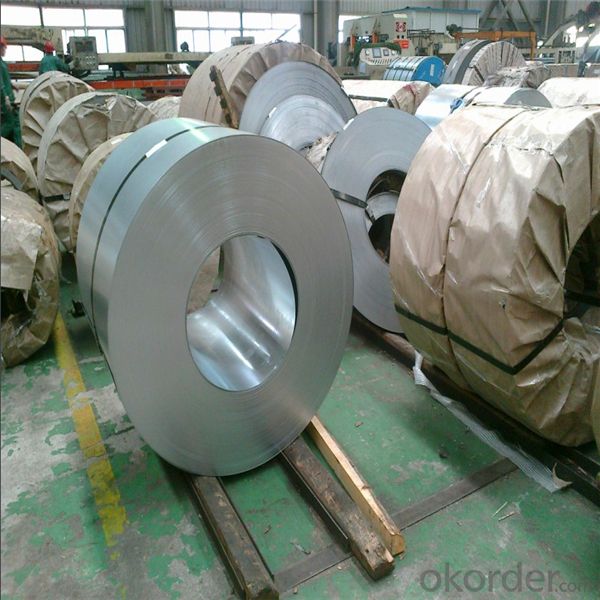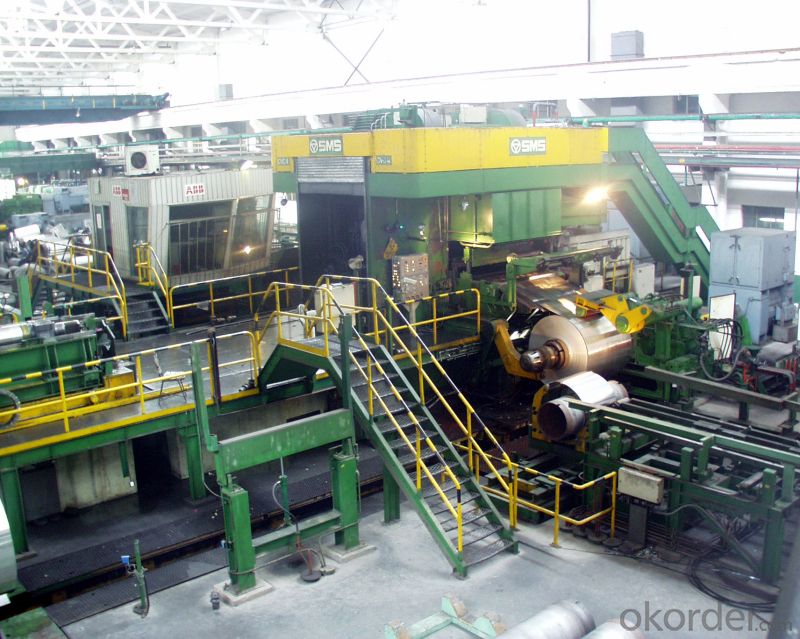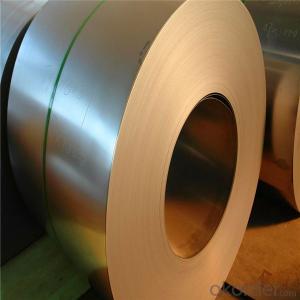SPCC Cr Coil/Cold Rolled Steel Coil for Building
- Loading Port:
- China main port
- Payment Terms:
- TT OR LC
- Min Order Qty:
- 10 m.t.
- Supply Capability:
- 50000 m.t./month
OKorder Service Pledge
OKorder Financial Service
You Might Also Like
Item specifice
SPCC CR Coil Cold Rolled Steel Coil for building
1.Cold Rolled Steel Coil
1.Thickness:0.18-1.8mm
2.Width:700-1300mm
3.Length:as your need
4.Inner Diameter: 508mm
5.Weight of Steel Coil: 3-15MT
6.Heat Treatment: Annealed
7.Surface Quality: FB&FC
8.Surface Status: SB & SD
9.Surface Treatment: Oiling,unoil,dry,chromate passivated, non-chromate passivated
10.Standard:AISI, ASTM, BS, DIN, GB, JIS
11.Grade;SPCC/SPCD/SPCE/ST12-15/DC01-06.
12.Delivery time:15-20days after receipting the advance payment.
13.Package: Standard export packing or as your requested.
14.Technique: Cold rolled.
15.Application:Widely used in ships, automobiles, bridges, buildings, machinery, etc
16.Price terms: FOB CIF CFR
17.Payment : T/T or L/C at sight
18.Samples are available
2.Product Image



3.Packing and Delivery
Delivery time:15-20days after receipting the advance payment.
Package: Standard export packing or as your requested.
Technique:Surface Treatmentunoil,dry,chromate passivated, non-chromate passivated
Application:Widely used in ships, automobiles, bridges, buildings, machinery, etc
- Q:How are steel coils protected against fire and heat?
- Steel coils are protected against fire and heat through a variety of methods to ensure their safety. One of the primary ways to safeguard steel coils is by applying a fire-resistant coating. These coatings are designed to provide a barrier between the steel surface and the heat source, preventing direct contact and reducing the risk of ignition or damage. In addition to coatings, steel coils can also be stored in fire-resistant warehouses or storage facilities. These structures are constructed using materials that are resistant to fire, such as concrete or steel, and are equipped with fire suppression systems like sprinklers or fire extinguishers. These measures help to contain and suppress any potential fire, limiting its spread and protecting the steel coils. Furthermore, fire safety protocols and procedures are often implemented in facilities that handle steel coils. These may include regular fire drills, training programs for employees on fire prevention and response, and the presence of fire safety equipment like fire alarms and fire hoses. These measures ensure that any fire incidents can be promptly detected and addressed, minimizing the risk to the steel coils. Overall, the protection of steel coils against fire and heat involves a combination of fire-resistant coatings, proper storage in fire-resistant structures, and the implementation of fire safety protocols. These measures work together to mitigate the risk of fire and heat-related damage to the steel coils, ensuring their integrity and safety.
- Q:Hi, does anyone know where i can find more about this topic ? fire resistant steels for structural applications. thanks
- Gavin, the danger posed by steel columns and girders during a fire in a building, is not the danger of the steel melting but of the steel expanding and snapping the bolts that hold all of the steel together. Very high temperatures can be achieved in a building fire because the up-draft caused by the rising hot air, delivers a massive amount of oxygen to the burning carpet, paper and furniture. When a steel frame office tower burns, the heat expands the steel and snaps the bolts. This causes the building to fall-down and not necessarily, burn-down. I am too lazy to look-up the melting point of steel but it is not very high. That is one reason for the columns and girders in steel framed buildings, to be covered in asbestos (which is a fatally toxic material) or magnesium di-oxide.
- Q:What are the different methods of heat treatment for steel coils?
- There are several methods of heat treatment for steel coils, including annealing, quenching, tempering, normalizing, and stress relieving. Each method involves heating the steel to a specific temperature and then cooling it in a controlled manner to achieve desired properties such as increased hardness, improved strength, or reduced residual stresses. These methods can be tailored based on the specific requirements of the steel and the intended application.
- Q:Can steel coils be stored outdoors?
- Steel coils can be stored outdoors, but it is important to protect them from moisture and other environmental elements to prevent rust and damage.
- Q:What are the common coil coating materials?
- The common coil coating materials include polyester, polyvinylidene fluoride (PVDF), polyurethane, epoxy, and acrylic.
- Q:Explain your answers please. I was watching mythbusters and they bought a steel coffin over a wooden one because they thought it would hold more dirt. Now how come bridges that have been made of wood lasted way longer than steel bridges? Or rollercoasts for example.
- steel.
- Q:Building the bulwurk, general use on trawlers. What kind of steel is best suited.
- Best amusing on right here in a while ,simply heading to the harbour bar to look at the fleet are available ,Booboo edged for me ,preferred the Liverpool one ,probably subsequent time we ll inform Chrispen its just a pleasant raid ,however excellent ,the entire equal
- Q:What are the common methods of joining steel coils together?
- Common methods of joining steel coils together include welding, mechanical fastening (such as using bolts or screws), adhesive bonding, and interlocking methods.
- Q:How do steel coil manufacturers handle custom orders?
- Steel coil manufacturers handle custom orders by first understanding the specific requirements and preferences of the customer. They then work closely with the customer to determine the desired specifications, including dimensions, thickness, width, coating, and any other specific requirements. The manufacturer uses their expertise and production capabilities to customize the steel coils accordingly. This may involve adjusting the production process, modifying machinery settings, or using different materials. Effective communication and collaboration between the manufacturer and the customer play a crucial role in ensuring the successful fulfillment of custom orders.
- Q:What are the different methods of punching steel coils?
- For punching steel coils, there are several methods available that vary depending on specific requirements and desired outcomes. The following are some commonly used methods: 1. Mechanical Punching: To create holes in the steel coil, a mechanical press is employed. This method involves utilizing a punch and die set, where the coil is subjected to force from the punch to create the hole. Mechanical punching is best suited for small to medium-sized holes and finds frequent use in high-volume production settings. 2. Hydraulic Punching: In hydraulic punching, hydraulic pressure is utilized to drive the punch into the steel coil. This method is commonly employed for punching larger holes or shapes that demand greater force. Hydraulic punching machines offer precise control and can handle thicker and harder materials. 3. Laser Cutting: Laser cutting is a non-contact technique that employs a laser beam to cut through the steel coil. By directing a focused laser beam onto the coil, the material is melted and evaporated to form the desired shape or hole. Laser cutting provides high precision and can be used for complex shapes and patterns. 4. Plasma Cutting: Plasma cutting involves the use of a high-velocity jet of ionized gas (plasma) to melt and remove the steel coil material. This method is suitable for cutting thicker steel coils and is often employed for larger holes or irregular shapes. 5. Waterjet Cutting: Waterjet cutting uses a high-pressure jet of water mixed with abrasive particles to cut through the steel coil. This method is versatile and can effectively cut various materials, including steel. Waterjet cutting is renowned for its high precision and clean cuts. Each method of punching steel coils possesses its own advantages and considerations. Factors such as material thickness, desired precision, production volume, and cost will determine the most suitable method for a specific application.
1. Manufacturer Overview |
|
|---|---|
| Location | |
| Year Established | |
| Annual Output Value | |
| Main Markets | |
| Company Certifications | |
2. Manufacturer Certificates |
|
|---|---|
| a) Certification Name | |
| Range | |
| Reference | |
| Validity Period | |
3. Manufacturer Capability |
|
|---|---|
| a)Trade Capacity | |
| Nearest Port | |
| Export Percentage | |
| No.of Employees in Trade Department | |
| Language Spoken: | |
| b)Factory Information | |
| Factory Size: | |
| No. of Production Lines | |
| Contract Manufacturing | |
| Product Price Range | |
Send your message to us
SPCC Cr Coil/Cold Rolled Steel Coil for Building
- Loading Port:
- China main port
- Payment Terms:
- TT OR LC
- Min Order Qty:
- 10 m.t.
- Supply Capability:
- 50000 m.t./month
OKorder Service Pledge
OKorder Financial Service
Similar products
New products
Hot products
Related keywords




























